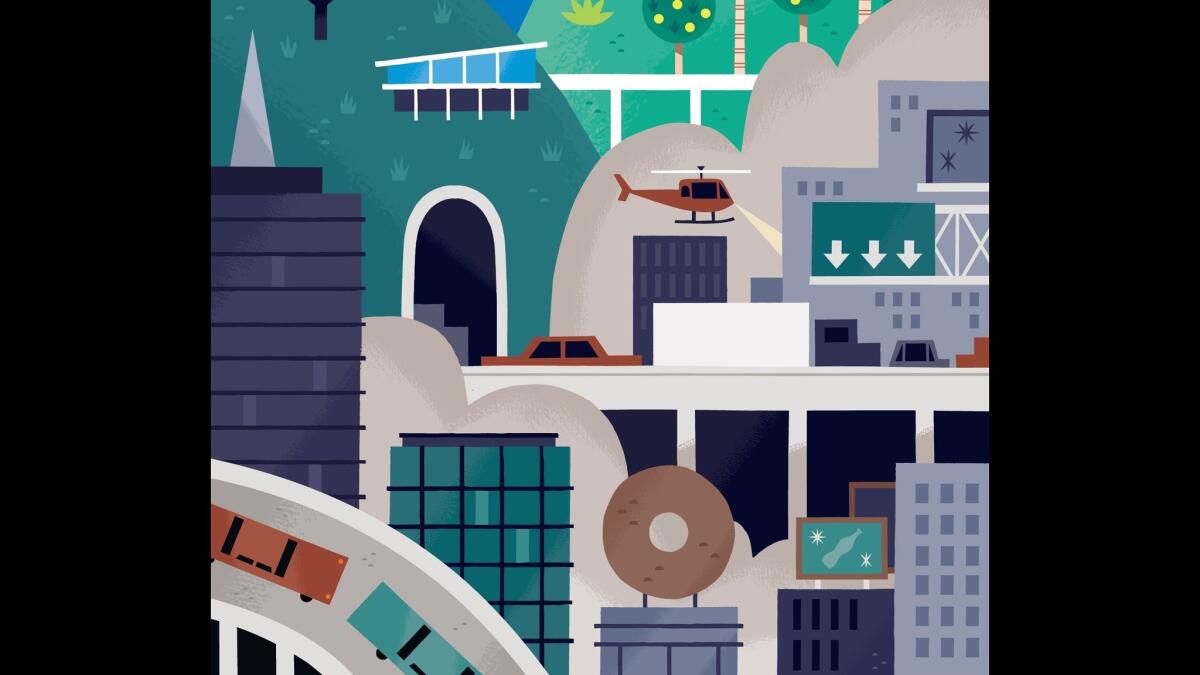Op-Ed: A letter from 2056: Dystopian L.A. gives you everything you love to hate, only more of it

- Share via
I am reaching out across the 4th Dimension to bring you a State of the City report from the year 2056. The good news is that our city is as famous (and infamous) as ever. People have never stopped moving here, from everywhere. And our amenities are through the roof! There are now more food trucks than cars, Restoration Hardwares outnumber 7-Elevens and in the city of Vernon, you can find eight independent, self-roasting coffeehouses between the railroad tracks and the Exide plant.
Other than that, the city’s not looking too great.
Traffic has steadily increased to the point where it takes a full day to commute from Northridge to Santa Monica or from Long Beach to Hollywood. Full-time workers now leave home Sunday, arrive at work Monday, stay overnight at their businesses the entire week and depart work Friday, getting home Saturday — if they’re lucky. All the freeways are now dotted with Starbucks and Carl’s Jr. locations, with servers bringing food and beverages to the stopped driver’s window by foot.
Although L.A. does have the world’s largest, most expensive museum, that’s really nothing to brag about. It goes by the name “Metro Light Rail,” which started as a public transportation project but never attracted significant ridership — not even after taxpayers funded the Teal, Chartreuse, Beige and Alabaster lines. Eventually, the government figured it was more cost effective to charge tourists and urban art appreciators $20 per ride than to extort $3.50 from car-less unfortunates.
Even the much vaunted Subway to the Sea went bust after the tsunami of 2021, followed by Santa Monica’s total rebuild of its flattened coast. Every structure became an $8-million dollar ultra-modern condominium, leading to a re-zoning of the beach from public to private.
Neighborhood names in Los Angeles have mutated and multiplied, and today you can visit Valley Village, Valley View, Valley Meadow, Valley Glen, Valley Glengarry Glen Ross, Valley Alley, Valley of the Stars, Valley of the Co-Stars, Valley Kingdom and Valley Republic.
Similarly, the number of organized street gangs continues to grow as old ones splinter and new ones form. In 2056, the only attire choices considered safe and neutral in gang territory (everything between the 710 and the 405 freeways) are the color metallic phosphorous, the pattern argyle and American flag stovepipe hats.
Thousands of ... tent-dwelling transients hold regular office jobs but cannot afford the real estate prices in and around the city.
Aspiring actors have never had the easiest time finding work in L.A., but the population of unemployed, over-trained thespians is now such that many have gone feral and roam the streets, wild-eyed and with script sides in hand, aggressively charging strangers and demanding that they act as scene partners. To get the problem under control, the cities of West Hollywood and Santa Monica have reclassified public improvisation as a first-degree felony. (Meanwhile, they have decriminalized all drugs, including crystal meth.)
As for L.A.’s education system, there is now a smaller population of young children in public elementary schools than there is of 20-, 30- and 40-somethings in acting classes. This is partly because the overwhelming majority of L.A. schools are now charters. The most desirable, in case you’re curious, are Lower Mar Vista Heights School for Socio-Religio-Economic Justice, Randy Quaid Academy and Hollywood Hills Public Relations Magnet Kindergarten.
Aesthetically, Hollywood now resembles a cross between “Blade Runner” and “Tetris.” Every major boulevard is jammed wall to wall with 80-story residential buildings featuring carbon-graphite, industrial-strength air filtration, roof-deck helicopter landing pads and wine cellar-equipped panic rooms.
A little to the east, skid row (officially enlarged to skid rows 1-10) now features soup kitchens offering “tasteful, semi-sophisticated small bites for the non-property encumbered urbanite.” Many thousands of these tent-dwelling transients hold regular office jobs but cannot afford the real estate prices in and around the city. One-bedroom apartments downtown average $8,200 per month, and that doesn’t include parking, storage, utilities, appliances or, in some cases, windows. In Outer Carthay Circle, an 8-foot-by-6-foot storage shed with plenty of living space for two small dogs and a sedentary cat recently sold for $1.2 million.
The “Big One” finally came, ripping a giant, yawning split in the ground from the Griffith Observatory to the city of Carson, allowing cooler-then-ever Eastsiders to say, “Oh, I don’t go west of the quake ravine.” The drought is now so serious that residents water lawns with inexpensive bottled water (from the 199 Cents Store — inflation’s a killer). And lines form around the block on weekends for people to see — and hug — the city’s one remaining leafy deciduous tree, on display next to LACMA.
For a healthy, idyllic lifestyle, you may want to start looking at Barstow, Flagstaff or Yuma. But if you decide to stay in L.A., I highly recommend the ultra-oxygenated, deprivation tank yoga place on the Culver City-Fairfax Gulch border.
Adam Gropman is a comedy writer and performer living in Valley Manor Estates Adjacent.
ALSO
A letter from 2056: Utopian L.A. is where everyone wants to live
Follow the Opinion section on Twitter @latimesopinion or Facebook
More to Read
A cure for the common opinion
Get thought-provoking perspectives with our weekly newsletter.
You may occasionally receive promotional content from the Los Angeles Times.









